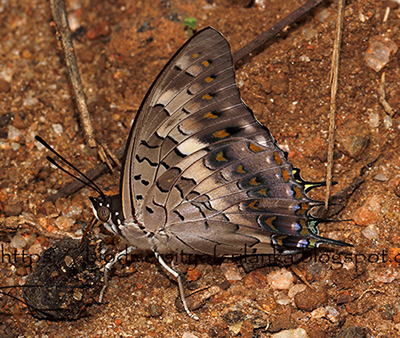Pages
- Home
- Flora of Sri Lanka
- Dragonflies & Damselflies of Sri Lanka
- Butterflies of Sri Lanka
- Freshwater Fishes of of Sri Lanka
- Amphibians of Sri Lanka
- Snakes of Sri Lanka
- Tetrapod Reptiles of Sri Lanka
- Mammals of Sri Lanka
- Resident Birds of Sri Lanka
- Migrant Birds of Sri Lanka
- Vagrant Birds of Sri Lanka
- Status Uncertain or Doubtful Birds of Sri Lanka
Tuesday, January 31, 2023
Black Rajah (Charaxes solon cerynthus)
Sunday, December 26, 2021
Indian Awl King (Choaspes benjaminii)
Indian Awl King is a rather uncommon butterfly restricted to the hill country forests above 1500 m a.s.l. But there are few records of observing it at some slightly lower elevations as well. Its larval food plants are Meliosma simplicifolia (ඇල්බැද්ද) and Meliosma arnottiana (නික දවුල). Male Indian Awl Kings are usually settle on wet roads, stream beds and strongly attracted by bird droppings. As per W. Ormiston who wrote about this butterfly in 1924 it was a fairly common butterfly of the hills and was formerly very plentiful on the cart road below the Haputale jungle, but he noted that since the Forest Department has cleared out the original vegetation and planted Eucalyptus in its places this and other butterflies have, of course disappeared. But he mentioned that it was still common between Haputale and Ohiya. He had collected it from Maskeliya, the hills above Ratnapura, Kandy as well as Haldummula which is rather low as 3500 ft.
Sunday, February 28, 2021
Ceylon Hedge Blue/Sri Lanka Hedge Blue (Udara lanka)
An endemic butterfly common in the forested areas above 1100 m elevations. It is much common in the first four months of the year, especially at the Horton Plains National Park and the vicinity. Both male and female flies in the canopy to feed on nectar of forest flowers. The male also descends to the ground to mudsip and to feed on scats. Its larva feeds on flower buds and seed pods of Smithia blanda. Persicaria chinensis is also identified as a larval food plant of this butterfly.
Saturday, December 5, 2020
Red-veined Darter (Sympetrum fonscolombii)
Rather rare insect confined to the marshes, swamps and lakes of the central hills (Mainly to the vicinity of Nuwaraeliya and Horton Plains National Park.)
Sunday, June 28, 2020
Rare Ace (Halpe egena)
Sunday, October 6, 2019
Common Guava Blue/Woodapple Blue (Virachola isocrates)
 Rather common butterfly but seldom seen since it inhabits mainly the canopy. Widely distributed in arid, dry and intermediate zones of the country where its principal larval food plant Limonia acidissima (Woodapple/දිවුල්) grows. Its main flight season is from June to September. Larva feeds on the soft pulp of the Woodapple fruit after eating its way into the fruit through its hard shell. It also prevents the fruit fall by spinning a web around its stalk and top of the fruit. In Sri Lanka, Common Guava Blue larva also feeds on කුකුරුමාන් (Catunaregam spinosa) and දෙළුම්/Pomergranate (Punica granatum) fruits.
Rather common butterfly but seldom seen since it inhabits mainly the canopy. Widely distributed in arid, dry and intermediate zones of the country where its principal larval food plant Limonia acidissima (Woodapple/දිවුල්) grows. Its main flight season is from June to September. Larva feeds on the soft pulp of the Woodapple fruit after eating its way into the fruit through its hard shell. It also prevents the fruit fall by spinning a web around its stalk and top of the fruit. In Sri Lanka, Common Guava Blue larva also feeds on කුකුරුමාන් (Catunaregam spinosa) and දෙළුම්/Pomergranate (Punica granatum) fruits.Sunday, August 11, 2019
Sunday, August 4, 2019
Wednesday, July 31, 2019
Monday, July 15, 2019
Green Pergesa Hawkmoth (Pergesa acteus)
Wing expanse - 6 to 7 cm
Food Plants - Elephant Ear/Caladium bicolor (Sujeeva Gunasena, Personal communication), පණු අල /Typhonium trilobatum (Moore F., 1882-3)
Life Cycle - https://www.facebook.com/kamanijeeva/media_set?set=a.1299671540099821&type=3
Reference - The Lepidoptera of Ceylon - F. Moore, F.Z.S. Vol 2 Page 23.
External Links - https://www.inaturalist.org/taxa/322014-Pergesa-acteus
Sunday, July 7, 2019
Thursday, July 4, 2019
Adam's Shadowdamsel (Ceylonosticta adami)
Wednesday, July 3, 2019
Sunday, June 2, 2019
Ceylon Treebrown (Lethe daretis)
Monday, May 27, 2019
Friday, March 15, 2019
Crimson Tip (Colotis danae danae)
Monday, March 11, 2019
Striped Pierrort (Tarucus nara)
Wednesday, February 6, 2019
Yellow Orange Tip (Ixias pyrene cingalensis)
Wednesday, January 30, 2019
Plain Orange Tip (Colotis aurora)
 Plain Orange Tip occurs only in coastal waste places and thorn scrub of the northern and north western part of the country. It is more numerous at the end of the north east monsoon though few may be seen all the year round. It flies usually closer to the ground. Its larva feeds on Cadaba fruticosa of the family Capparaceae.
Plain Orange Tip occurs only in coastal waste places and thorn scrub of the northern and north western part of the country. It is more numerous at the end of the north east monsoon though few may be seen all the year round. It flies usually closer to the ground. Its larva feeds on Cadaba fruticosa of the family Capparaceae.















